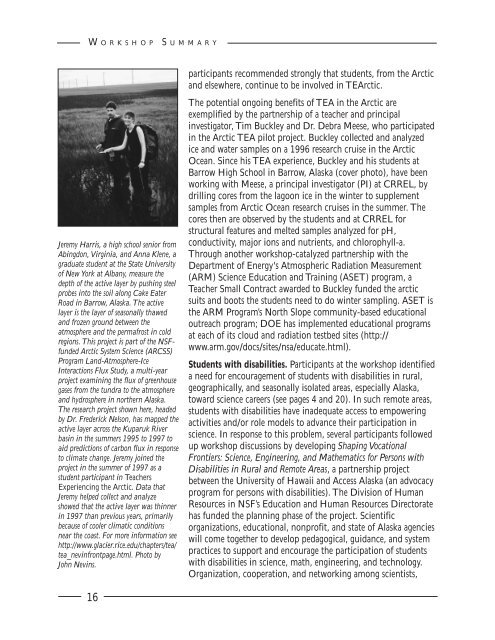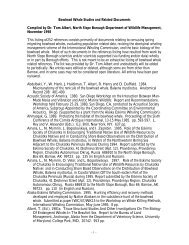ed report 4 page cover - Arctic Research Consortium of the United ...
ed report 4 page cover - Arctic Research Consortium of the United ...
ed report 4 page cover - Arctic Research Consortium of the United ...
You also want an ePaper? Increase the reach of your titles
YUMPU automatically turns print PDFs into web optimized ePapers that Google loves.
W O R K S H O P S U M M A R Y<br />
Jeremy Harris, a high school senior from<br />
Abingdon, Virginia, and Anna Klene, a<br />
graduate student at <strong>the</strong> State University<br />
<strong>of</strong> New York at Albany, measure <strong>the</strong><br />
depth <strong>of</strong> <strong>the</strong> active layer by pushing steel<br />
probes into <strong>the</strong> soil along Cake Eater<br />
Road in Barrow, Alaska. The active<br />
layer is <strong>the</strong> layer <strong>of</strong> seasonally thaw<strong>ed</strong><br />
and frozen ground between <strong>the</strong><br />
atmosphere and <strong>the</strong> permafrost in cold<br />
regions. This project is part <strong>of</strong> <strong>the</strong> NSFfund<strong>ed</strong><br />
<strong>Arctic</strong> System Science (ARCSS)<br />
Program Land-Atmosphere-Ice<br />
Interactions Flux Study, a multi-year<br />
project examining <strong>the</strong> flux <strong>of</strong> greenhouse<br />
gases from <strong>the</strong> tundra to <strong>the</strong> atmosphere<br />
and hydrosphere in nor<strong>the</strong>rn Alaska.<br />
The research project shown here, head<strong>ed</strong><br />
by Dr. Fr<strong>ed</strong>erick Nelson, has mapp<strong>ed</strong> <strong>the</strong><br />
active layer across <strong>the</strong> Kuparuk River<br />
basin in <strong>the</strong> summers 1995 to 1997 to<br />
aid pr<strong>ed</strong>ictions <strong>of</strong> carbon flux in response<br />
to climate change. Jeremy join<strong>ed</strong> <strong>the</strong><br />
project in <strong>the</strong> summer <strong>of</strong> 1997 as a<br />
student participant in Teachers<br />
Experiencing <strong>the</strong> <strong>Arctic</strong>. Data that<br />
Jeremy help<strong>ed</strong> collect and analyze<br />
show<strong>ed</strong> that <strong>the</strong> active layer was thinner<br />
in 1997 than previous years, primarily<br />
because <strong>of</strong> cooler climatic conditions<br />
near <strong>the</strong> coast. For more information see<br />
http://www.glacier.rice.<strong>ed</strong>u/chapters/tea/<br />
tea_nevinfront<strong>page</strong>.html. Photo by<br />
John Nevins.<br />
16<br />
participants recommend<strong>ed</strong> strongly that students, from <strong>the</strong> <strong>Arctic</strong><br />
and elsewhere, continue to be involv<strong>ed</strong> in TE<strong>Arctic</strong>.<br />
The potential ongoing benefits <strong>of</strong> TEA in <strong>the</strong> <strong>Arctic</strong> are<br />
exemplifi<strong>ed</strong> by <strong>the</strong> partnership <strong>of</strong> a teacher and principal<br />
investigator, Tim Buckley and Dr. Debra Meese, who participat<strong>ed</strong><br />
in <strong>the</strong> <strong>Arctic</strong> TEA pilot project. Buckley collect<strong>ed</strong> and analyz<strong>ed</strong><br />
ice and water samples on a 1996 research cruise in <strong>the</strong> <strong>Arctic</strong><br />
Ocean. Since his TEA experience, Buckley and his students at<br />
Barrow High School in Barrow, Alaska (<strong>cover</strong> photo), have been<br />
working with Meese, a principal investigator (PI) at CRREL, by<br />
drilling cores from <strong>the</strong> lagoon ice in <strong>the</strong> winter to supplement<br />
samples from <strong>Arctic</strong> Ocean research cruises in <strong>the</strong> summer. The<br />
cores <strong>the</strong>n are observ<strong>ed</strong> by <strong>the</strong> students and at CRREL for<br />
structural features and melt<strong>ed</strong> samples analyz<strong>ed</strong> for pH,<br />
conductivity, major ions and nutrients, and chlorophyll-a.<br />
Through ano<strong>the</strong>r workshop-catalyz<strong>ed</strong> partnership with <strong>the</strong><br />
Department <strong>of</strong> Energy's Atmospheric Radiation Measurement<br />
(ARM) Science Education and Training (ASET) program, a<br />
Teacher Small Contract award<strong>ed</strong> to Buckley fund<strong>ed</strong> <strong>the</strong> arctic<br />
suits and boots <strong>the</strong> students ne<strong>ed</strong> to do winter sampling. ASET is<br />
<strong>the</strong> ARM Program’s North Slope community-bas<strong>ed</strong> <strong>ed</strong>ucational<br />
outreach program; DOE has implement<strong>ed</strong> <strong>ed</strong>ucational programs<br />
at each <strong>of</strong> its cloud and radiation testb<strong>ed</strong> sites (http://<br />
www.arm.gov/docs/sites/nsa/<strong>ed</strong>ucate.html).<br />
Students with disabilities. Participants at <strong>the</strong> workshop identifi<strong>ed</strong><br />
a ne<strong>ed</strong> for encouragement <strong>of</strong> students with disabilities in rural,<br />
geographically, and seasonally isolat<strong>ed</strong> areas, especially Alaska,<br />
toward science careers (see <strong>page</strong>s 4 and 20). In such remote areas,<br />
students with disabilities have inadequate access to empowering<br />
activities and/or role models to advance <strong>the</strong>ir participation in<br />
science. In response to this problem, several participants follow<strong>ed</strong><br />
up workshop discussions by developing Shaping Vocational<br />
Frontiers: Science, Engineering, and Ma<strong>the</strong>matics for Persons with<br />
Disabilities in Rural and Remote Areas, a partnership project<br />
between <strong>the</strong> University <strong>of</strong> Hawaii and Access Alaska (an advocacy<br />
program for persons with disabilities). The Division <strong>of</strong> Human<br />
Resources in NSF’s Education and Human Resources Directorate<br />
has fund<strong>ed</strong> <strong>the</strong> planning phase <strong>of</strong> <strong>the</strong> project. Scientific<br />
organizations, <strong>ed</strong>ucational, nonpr<strong>of</strong>it, and state <strong>of</strong> Alaska agencies<br />
will come toge<strong>the</strong>r to develop p<strong>ed</strong>agogical, guidance, and system<br />
practices to support and encourage <strong>the</strong> participation <strong>of</strong> students<br />
with disabilities in science, math, engineering, and technology.<br />
Organization, cooperation, and networking among scientists,




